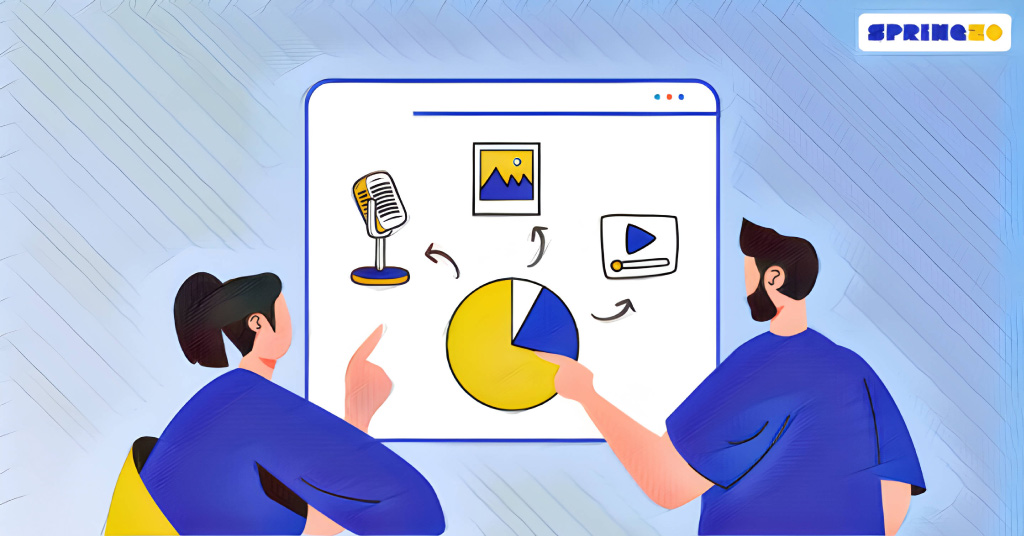Have you ever wondered how you can extend the reach and impact of your existing content and improve your ROI without the constant need to create new material from scratch? Even if it sounds too good to be true, it’s possible when you repurpose content!
With 94% of marketers actively repurposing their content, it is high time to embrace this practice and tap into the potential of your existing content.
Repurposing is not just some trendy hack; it’s a strategy that savvy businesses swear by. In fact, businesses that repurpose content experience a 47% increase in website conversion rates!
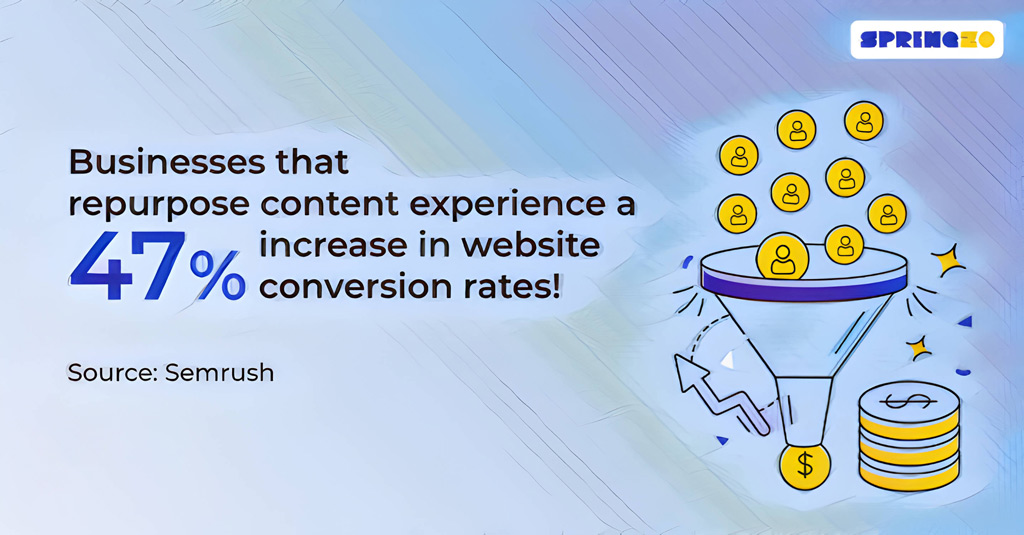
In this article, we will delve into the world of content repurposing, exploring its myriad benefits and unveiling five tactics that guarantee unprecedented results. Let’s dive in!
Repurpose Content: An Overview
So, what exactly does it mean to repurpose content?
Well, to put it simply, it involves taking existing content and transforming it into different formats or adapting the content for various platforms, all the while helping you make the most of your existing content and improving the ROI.
This strategy allows you to extend the lifespan of your content, reach new audiences, and reinforce your brand messaging.
Why Repurpose Content: Key Benefits
Let’s take a closer look at the benefits you can garner when you repurpose content:
1. Maximizing the value of existing content
Why let your valuable branded content sit idle? Repurposing gives it a second chance to shine and provide enhanced value to your audience.
2. Expanding reach and audience engagement
Different people prefer different types of content. When you repurpose content, you cater to various preferences and capture the attention of a wider audience.
3. Increasing brand visibility and awareness
It also helps boost your brand’s visibility across multiple channels and platforms and keeps it at the forefront of your audience’s minds.
4. Enhancing Search Engine Optimization (SEO) efforts
Consecutively, it also creates additional opportunities for search engines to discover and rank your brand, improving your overall SEO performance. In a competitor-dense business landscape, it can be a pivotal factor.
5. Building thought leadership and authority
When you consistently repurpose content, you establish yourself as an expert in your field, earning the trust and respect of your audience.
Repurpose Content: Types of Content Amplifying Reach
Now, let’s talk about the various types of content you can repurpose.
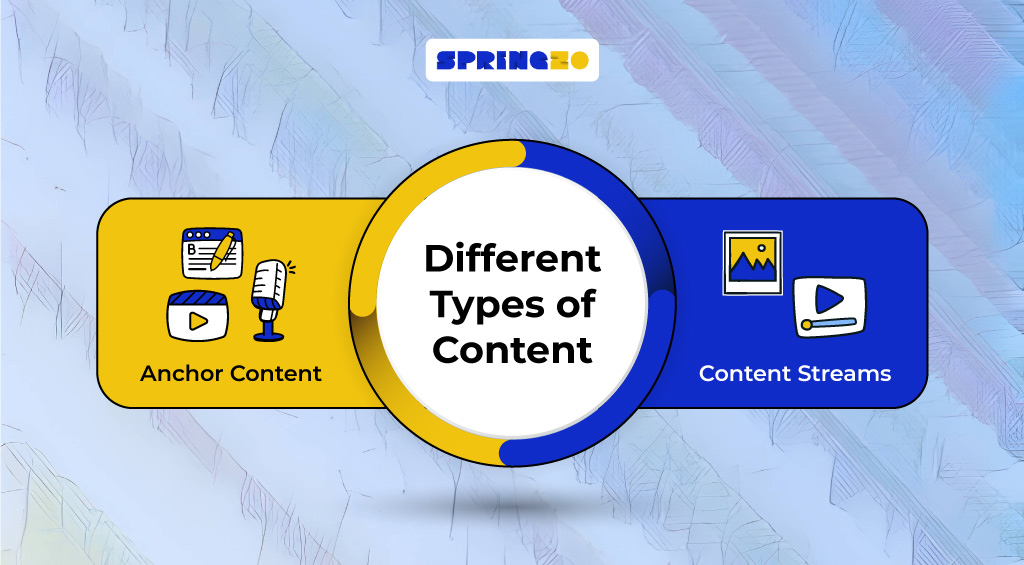
1. Anchor Content
Anchor content is high-quality, comprehensive, and evergreen content that serves as the centerpiece of a content strategy. It provides substantial value to the audience, establishes authority, and attracts organic traffic over a long period of time.
Examples include in-depth guides in blog formats, tutorials, podcast episodes, and research studies.
2. Content Streams
Content streams are regular, shorter, and more timely content pieces that complement your anchor content and can be repurposed from your existing content. Content streams help you stay relevant, maintain a consistent presence, and keep your audience updated on the latest trends and news.
Now that you understand the basics let’s dive into some examples of content repurposing strategies.
Effective Content Repurposing Strategies: 4 Examples
Some of the most impactful content repurposing strategies involve the following:
1. Transforming blog posts into visual content
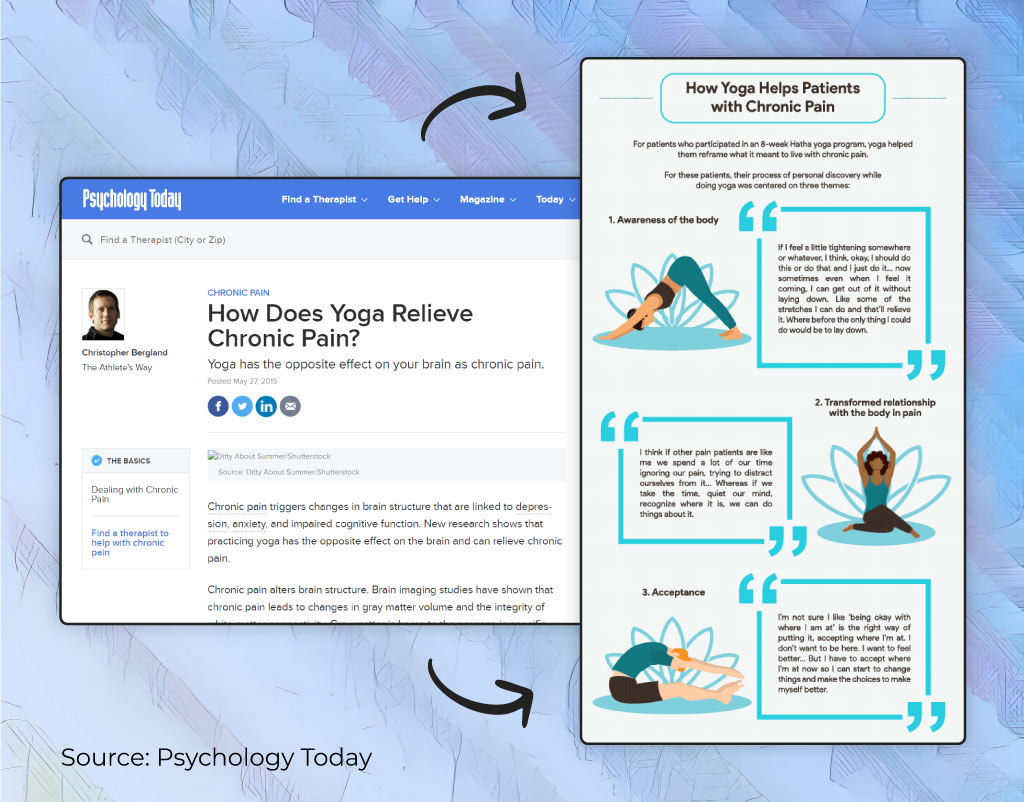
One effective strategy is to repurpose your blog posts into visually engaging content. For example, take a comprehensive blog post that explains a complex topic and transform it into an infographic.
Condense the key points, use visual elements, and present the information in a visually appealing format. This not only makes the content more digestible but also increases its shareability on social media platforms.
Another option is to convert blog posts into videos, where you can summarize the main ideas, include relevant visuals, and create a captivating narrative. These videos can be shared on YouTube, social media, or embedded in your blog posts to reach a wider audience.
2. Converting webinars or presentations into downloadable assets
If you’ve conducted webinars or presentations that contain valuable insights, repurpose them into downloadable assets such as ebooks or whitepapers.
Extract the key points, add additional context, and organize the content into a cohesive and visually appealing format.
By transforming your presentations into downloadable assets, you provide your audience with a convenient way to access and consume the information. These assets can serve as lead magnets, generating valuable email sign-ups and expanding your reach.
3. Creating social media posts from long-form content
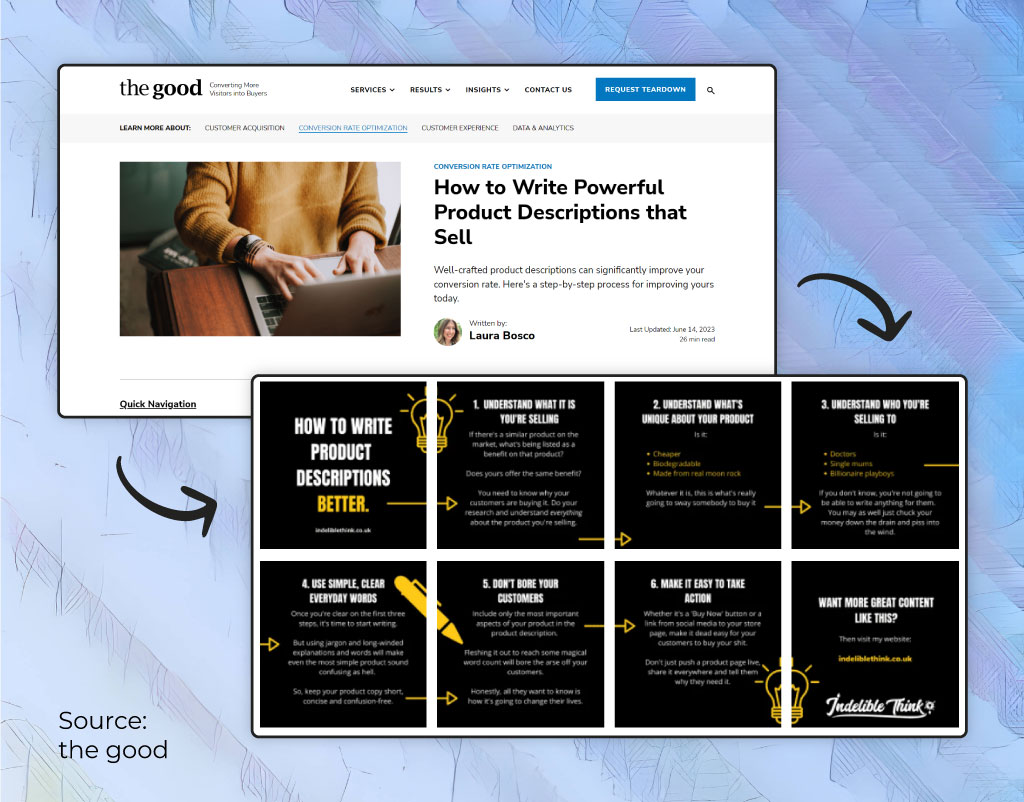
Long-form content, such as articles or guides, can be repurposed into engaging social media posts. Identify the most intriguing snippets, statistics, or quotes from the original content and craft compelling captions around them.
Include attention-grabbing visuals or graphics to enhance the visual appeal. When you rework your longer-form content into bite-sized social media posts, you can spark curiosity, drive traffic back to your website, and generate engagement and shares.
4. Adapting content for different platforms
Adapting your content for different platforms allows you to reach diverse audiences. For example, you can repurpose a blog post into a podcast episode by converting the text into a script and recording it as an audio file.
This allows you to tap into the podcasting audience and provide them with valuable content in the format they prefer.
Additionally, consider repurposing your content as guest articles for industry publications or as contributions to relevant platforms such as Medium, LinkedIn Pulse, or industry-specific blogs.
Repurpose Content: 5 Tactics to Unleash Growth
In this section, we will explore six popular tactics that will help you achieve remarkable results through content repurposing:
1. Conduct a content audit and identify repurposing opportunities
To kick-start your content repurposing journey, conduct a thorough content audit. Evaluate your existing content library to identify high-performing pieces, evergreen topics, and untapped potential.
n essence, you have to look for opportunities to repurpose content that aligns with your goals and resonates with your audience.
For instance, if you have a blog post that received a significant amount of engagement and positive feedback from your audience, consider transforming it into a visually appealing infographic or a video that conveys the same valuable information in a different format.
2. Understand your target audience preferences and select suitable formats
Every audience has unique preferences when it comes to consuming content. That’s why understanding your target audience’s preferences is key to successful repurposing.
Analyze their behavior, consumption patterns, and engagement metrics to determine the formats that will best resonate with them.
For example, let’s consider a fitness-related website looking to repurpose content. By analyzing their audience’s behavior, consumption patterns, and engagement metrics, they discover that a significant portion of their visitors are young adults who lead busy lives and prefer consuming content on-the-go through their smartphones.
In this case, the website could tailor their repurposing efforts by creating short, visually engaging videos demonstrating quick and effective workouts that can be easily followed along on mobile devices.
Additionally, they might consider converting their most popular articles into easily digestible podcast episodes for their audience to listen to during their daily commutes or workout sessions.
3. Incorporate new perspectives and updates into repurposed content
To repurpose content doesn’t mean copy-pasting. Let’s say you have a blog post from last year on “Top 10 Productivity Hacks for Remote Workers.” To keep it fresh and relevant, imagine adding new perspectives, updates, and insights into your repurposed content.
For example, you could incorporate current statistics about the rise of remote work, expert quotes from leading remote work advocates, or recent case studies highlighting the success of certain productivity strategies in real-world scenarios.
By offering a new take on existing content, you can attract returning readers and entice new ones.
4. Creating a strategic content distribution plan
Here’s a guideline about how you can create a successful content distribution plan:
Step 1: Identify Relevant Channels and Communities
Start by identifying the channels, platforms, and communities where your target audience is most active and engaged. Conduct research to understand their preferences and behaviors to ensure your content reaches the right people.
Step 2: Optimize Content for Different Platforms
Tailor your repurposed content to suit each platform’s format and style. Remember that content designed for one platform may not perform well on another. Customizing the content will ensure it resonates with the audience on each specific channel.
Step 3: Create a Consistent Sharing Schedule
Develop a well-planned sharing schedule to ensure consistent visibility and engagement across all chosen channels. Consistency is key in keeping your audience engaged and informed about your content updates.
Step 4: Timing and Relevance
The feedback received mentioned the importance of context and timing. When we say timing is crucial, we mean that you need to consider the best times to share your content on each platform.
For example, posting on social media during peak hours when your audience is most active can significantly increase engagement. Additionally, align your content with current events or trending topics to make it more relevant and appealing to your audience.
By following these steps, you can develop a strategic content distribution plan that ensures when you repurpose content, it reaches the right people in the right format.
5. Ensure Effective Repurposing by Measuring and Analyzing Performance
Before you repurpose any content, it’s essential to understand the significance of measuring its effectiveness, whether you have already repurposed content or plan to do so in the future.
Analyzing the performance of your repurposed content involves closely examining key metrics like views, shares, engagement, and conversions using analytics tools. By identifying which types of repurposed content resonate best with your audience, you can optimize your approach and create more content that generates positive results.
Conversely, you can refine or discontinue content that doesn’t perform as well. This iterative process enables you to fine-tune your content marketing strategy.
Elevate Your Content Strategy: Embrace the Art of Repurposing
You’re now armed with the ins and outs of content repurposing, and it’s time to take action and harness its full potential.
Don’t let your valuable content go to waste—instead, repurpose it into different formats and adapt it for various platforms to maximize its value and impact.
If you’re looking for expert guidance in content repurposing or need comprehensive end-to-end content management services, Springzo is here to help.
Our specialization lies in content repurposing, making it the hero of our offerings. From ideation to content creation, we are dedicated to elevating your brand visibility and significantly improving the ROI of your anchor content.
Get in touch with us today to embark on your content repurposing journey and maximize the value of your content investments.
FAQs
1. How can content repurposing help improve my website’s SEO?
A: Content repurposing can improve your website’s SEO by creating additional opportunities for search engines to discover and rank your brand. When you repurpose content into different formats and publish it on various platforms, you increase the chances of gaining backlinks and mentions, which are essential for SEO. Additionally, repurposing allows you to target different keywords and topics, expanding your content’s relevancy and visibility in search engine results.
2. Can I repurpose user-generated content (UGC)?
A: Absolutely! Repurposing user-generated content can be a powerful way to showcase authentic customer experiences and engage your audience. With proper permissions from the content creators, you can repurpose UGC into testimonial videos, social media posts or even integrate it into your blog posts. Always credit the original creators to maintain transparency and build trust with your audience.
3. Is there any content that shouldn’t be repurposed?
A: While most content can be repurposed effectively, some types might not be suitable for certain platforms or audiences. For instance, highly technical content might not translate well into visual formats like infographics without simplification. Additionally, content that relies heavily on current trends or news events might have a limited shelf life and may not be worth repurposing in the long term.
4. How often should you repurpose content?
A: According to research findings, brands that publish content between two to four times per week tend to achieve optimal results from their content marketing efforts. By repurposing content, you gain a competitive advantage in this process, enabling quicker content creation and more frequent content publication.
5. How can I repurpose content for seasonal or holiday marketing campaigns?
A: To repurpose content for seasonal or holiday campaigns, you can:
a. Update existing content: Refresh relevant evergreen content with current data and trends to align with the holiday season.
b. Create themed visuals: Design holiday-themed graphics or videos that incorporate your brand message within the context of the occasion.
c. Craft seasonal guides: Convert existing blog posts or tutorials into holiday-themed guides or how-to resources.
d. Run social media contests: Repurpose content into interactive social media contests or challenges that tie into the holiday spirit.
